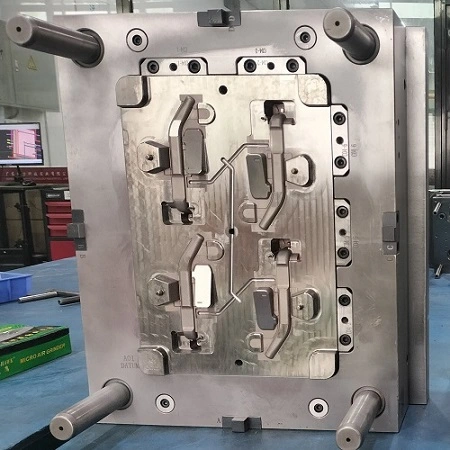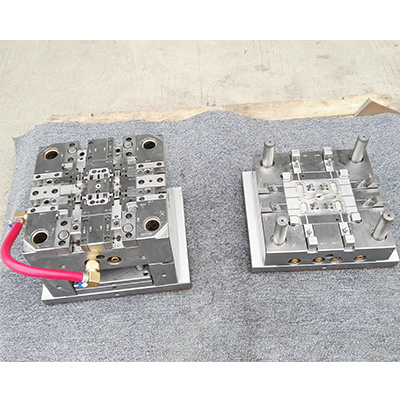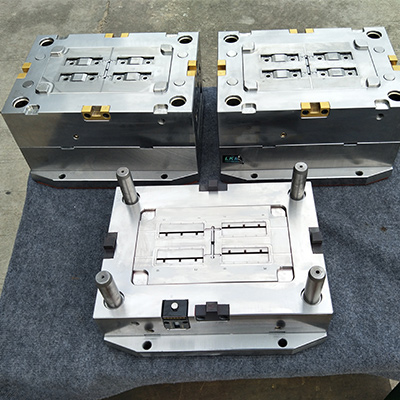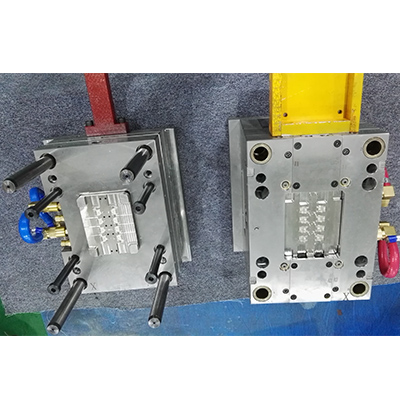





An automotive mold, also known as a car mold or automotive tooling, is a specialized tool used in the manufacturing process of automobile components. It is designed to shape and form various parts of a vehicle, such as body panels, interior components, engine parts, and other structural elements.
HanKing Mould serves global Automotive & Vehicle products customers, more than 10 years of experience enabling the HanKing team to provide customers the fast development time and stable quality to ensure the new project running well. HanKing engineer will analysis the filling to obtain the best gate position the best flowing regime, and design the best cooling channel to ensure the minimum wrapping deformation and we have a very good injection operator to help set the best injection parameter to avoid any development time waste and improving the molding parameter reliability.
HanKing Mould is very experienced in small and medium-sized precision auto parts molds, in the past years, the types of products we involved were included fuse and fuse box, connector, switch, relay, sensors, actuators, terminal, valve, handle and other body accessories. We are one of the leading automotive mold makers in China.
In the development of the automotive industry, the proportion of plastic parts in automotive parts is very large, and the demand for plastic parts is increasing day by day because plastics have the advantages of beautiful appearance, lightweight and easy processing. Most plastics have a specific gravity of 0.9 to 1.6, and the proportion of glass fiber reinforced composites will not exceed 2.0, while A3 steel is 7.6, brass is 8.4, and aluminum is 2.7. The use of plastic can reduce the weight of parts by about 40%, and the cost can be greatly reduced, which makes plastic the preferred material for automotive light-weighting. Plastic is easy to molding parts with complex shapes. According to the plastic composition of the plastic, by adding different fillers, plasticizers and hardeners to produce the desired properties of the plastic, changing the mechanical strength and processing properties of the material to meet the requirements of different parts of the car. The plastic consumption of each auto part accounts for 20% of the total vehicle materials and may reach 35% in the future. When the auto company develops a new car, it needs to use hundreds of sets of automotive plastic injection molds, which requires the quality assurance of plastic parts in production, and the quality of plastic parts is determined by the mold. Learn more about how to improve the quality of the mold.
Auto parts mold refers to a specialized tool used in the manufacturing process of automotive parts. It is a precision tool that is used to shape raw materials, typically plastic or metal, into the desired shape and size for use in automobiles.
Auto parts molds are typically made of high-quality steel and are designed to withstand high temperatures and pressure. They are used in injection molding machines, which melt the raw materials and then inject them into the mold to create the finished product.
Bumper, the instrument panel accessories, inlet grille, fender, radiator grille, trim panel, engine parts, Water tank accessories, air conditioning accessories, air filter accessories, various kettles, seat accessories, floor panel accessories, roof panel accessories, bar accessories, steering wheel accessories, door trims, rearview mirrors and various fastener, front and rear lamp, etc.
Body Panels: Automotive molds are extensively used to produce body panels like hoods, fenders, doors, roofs, and trunk lids. These molds ensure precision and consistency in the shape and size of the panels.
Interior Components: Molds are employed to create interior components like dashboard panels, center consoles, door trims, and seat components. They help achieve the desired aesthetics and functionality of the interior.
Engine Parts: Various engine components, such as cylinder heads, intake manifolds, and engine covers, are manufactured using molds. These molds ensure accuracy in the production of complex engine parts.
Precision and Consistency: Automotive molds enable the production of highly accurate and consistent parts, ensuring a proper fit and function within the vehicle.
Efficiency and Cost-effectiveness: By using molds, the manufacturing process becomes more efficient, as large quantities of parts can be produced with minimal variations. This leads to cost savings in terms of time and resources.
Design Flexibility: Molds allow for intricate designs and complex shapes to be replicated consistently, providing manufacturers with the flexibility to create innovative automotive components.
Material Selection: Automotive molds are typically made from high-quality materials such as steel, aluminum, or composite materials, depending on the specific requirements of the manufacturing process.
Venting and Cooling Systems: Molds are equipped with venting systems to release air and gases during the molding process, ensuring the quality of the final product. Cooling systems help control the temperature and solidification of the material.
Cavity and Core Design: Molds consist of cavity and core components that define the shape of the part being produced. These components can be customized to accommodate the desired design and functionality of the automotive component.
Surface Finish: Automotive molds can be designed to provide different surface finishes, including smooth, textured, or patterned surfaces, depending on the requirements of the part being produced.
Creating an automotive mold involves several steps. Here is a general overview of the process:
Design: The first step is to create a 3D design of the desired automotive component. This can be done using computer-aided design (CAD) software. The design includes all the necessary details, dimensions, and specifications of the part.
Material selection: The appropriate material for the mold is chosen based on factors such as the type of automotive component, production volume, desired finish, and cost. Common mold materials include steel, aluminum, and various alloys.
Mold base preparation: A mold base is prepared, which serves as the foundation for the mold. It provides support and houses various components like ejector pins, guide pins, and cooling channels. The mold base is usually made from steel and is machined to the required specifications.
Mold cavity creation: The mold cavity is formed by cutting or machining the mold base. This process involves using specialized equipment such as CNC milling machines, electrical discharge machines (EDM), or computer numerical control (CNC) lathes to precisely shape the mold cavity according to the design.
Cooling system installation: Cooling channels or passages are created within the mold to regulate the temperature during the molding process. These channels help in efficient cooling and solidification of the molten material. They are typically created using drills or EDM techniques.
Mold surface treatment: The mold surfaces that come into direct contact with the molten material are treated to enhance durability and release properties. Surface treatments may include polishing, texturing, or applying coatings such as chrome plating or nitriding.
Mold assembly: Various mold components, such as ejector pins, slides, and cores, are installed within the mold base to create a fully functional mold. These components enable the ejection of the molded part from the mold after the molding process.
Testing and adjustments: Once the mold is assembled, it undergoes testing to ensure proper functioning. Adjustments may be made to achieve the desired part quality, dimensions, and fit. This may involve trial runs and iterative modifications to optimize the mold.
Production: After the mold is tested and approved, it is ready for mass production. The mold is mounted onto an injection molding machine, where molten material, such as plastic or metal, is injected into the mold cavity under high pressure. The material then solidifies, conforming to the shape of the mold cavity.
Maintenance: Regular maintenance and cleaning of the mold are essential to ensure its longevity and consistent performance. This includes inspecting and repairing any damage, replacing worn components, and keeping the mold surfaces clean and free from contaminants.
It's important to note that the specific details of mold creation can vary depending on the complexity of the automotive component, the molding process used (e.g., injection molding, blow molding), and other factors specific to the manufacturing facility.






 Call us on:
Call us on:  Email Us:
Email Us:  No.23, XingYi Road, Wusha Community, Chang'an Town, Dongguan City, Guangdong Province, China.
No.23, XingYi Road, Wusha Community, Chang'an Town, Dongguan City, Guangdong Province, China.